
The Oldest House on Sunset Hill, also known as the Jethro Coffin House, was built in 1686 and is believed to be the oldest residence on Nantucket still on its original site. The island's English population at the time totaled several hundred, and the native Wampanoag outnumbered them by at least three to one.

St. Anne's Episcopal Church is a historic church at 29 Church Street in Calais, Maine. Built in 1853, it is a locally distinctive example of Carpenter Gothic architecture, and is the only known statewide work of architect James Renwick, Jr. The church building was listed on the National Register of Historic Places in 1982. It is a member of the Episcopal Diocese of Maine; its pastor is the Rev. Sara Gavit.

The Nathan and Mary (Polly) Johnson properties are a National Historic Landmark at 17–19 and 21 Seventh Street in New Bedford, Massachusetts. Originally two structures, one dating to the 1820s and an 1857 house joined with the older one shortly after construction. They have since been restored and now house the New Bedford Historical Society. The two properties are significant for their association with leading members of the abolitionist movement in Massachusetts, and as the only surviving residence in New Bedford of Frederick Douglass. Nathan and Polly Johnson were free African-Americans who are known to have sheltered escaped slaves using the Underground Railroad from 1822 on. Both were also successful in local business; Nathan as a [caterer] and Polly as a confectioner.
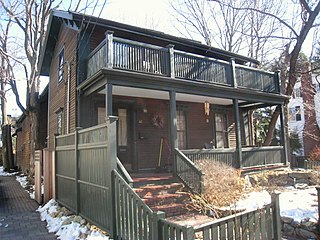
The John Aborn House is an historic house in Cambridge, Massachusetts. Built in 1846, it is one of west Cambridge's first examples of residential housing with Italianate features. It was listed on the National Register of Historic Places in 1982.

The James D. Hathaway House is a historic house located at 311 Pine Street in Fall River, Massachusetts.

The Christopher Carpenter House is a historic house at 60 Carpenter Street in Rehoboth, Massachusetts. Built about 1800, it is a particularly fine local example of Federal period architecture. It was listed on the National Register of Historic Places in 1983.
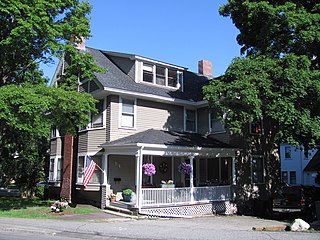
The Brande House is a historic house in Reading, Massachusetts. Built in 1895, the house is a distinctive local example of a Queen Anne Victorian with Shingle and Stick style features. It was listed on the National Register of Historic Places in 1984.

The Marcus Hobbs House is an historic house at 16 William Street in Worcester, Massachusetts. Built in 1849, it is an example of mid-19th century Greek Revival housing with added Italianate features. The house was listed on the National Register of Historic Places in 1980.
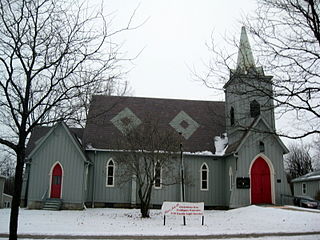
St. Peter's Episcopal Church is a historic Carpenter Gothic style Episcopal church located at 44 Main Street in Bloomfield, Ontario County, New York. Constructed in 1871, it is a small, board and batten, Carpenter Gothic style frame building. The 67 foot by 27 foot rectangular structure is surmounted by a sharply pitched gable roof featuring polychrome slate shingles set in a decorative diamond pattern. A square bell tower surmounted by a pyramidal spire is attached to the front corner of the main body of the church.

The Joseph Carpenter Silversmith Shop is a historic building that was built between 1772 and 1774 on the green in Norwichtown, now a section of Norwich, Connecticut. It is a 30 feet (9.1 m) by 24 feet (7.3 m) 1 1⁄2-story clapboarded building with a gambrel roof. The interior has a single brick chimney that was used for the forge, but it has been modified and adapted for modern use with modern doors, electric lighting and heat, and a disappearing overhead stairway that leads to the attic. Joseph Carpenter (1747–1804) was a successful of silversmith, clockmaker, and pewterer, and shared the building with his brother, a merchant. The shop was added to the National Register of Historic Places on October 6, 1970, and was listed as a contributory property for the Norwichtown Historic District on January 17, 1973.

Springbank is a historic country estate at 69 Neck Road in Old Lyme, Connecticut. The main house consists of an 1844 Greek Revival brick structure, to which a number of Colonial Revival additions and alterations were made between about 1930 and 1945. The property also includes a formal garden designed by landscape architect Marian Cruger Coffin. The property is notable as a well-documented and preserved smaller-scale example of her work. The property was listed on the National Register of Historic Places on August 17, 2001.

The Louis C. and Amelia L. Schmidt House is a historic building located in a residential neighborhood on the east side of Davenport, Iowa, United States. It was listed on the National Register of Historic Places in 2007.

The Arnold Stevens House is a historic house located in Jerome, Idaho. It is part of the Lava Rock Structures in South Central Idaho Thematic Resource and was listed on the National Register of Historic Places on September 8, 1983.

The First Methodist Episcopal Church, also known as the Red Church, is a historic church located at 4451 Second Street in Port Hope, Michigan. It was listed on the National Register of Historic Places in 1987.

The Seavey-Robinson House is a historic house built in the Carpenter Gothic style in South Portland, Maine. Built c. 1854-57, it is a rare example of a Carpenter Gothic cottage, originally built in a rural setting, since urbanized. It was added to the National Register of Historic Places in 1986.
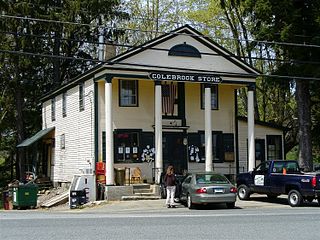
The Colebrook Store is a historic commercial building at 559 Colebrook Road in the village center of Colebrook, Connecticut. Built in 1812, it has operated as a local general store since then, and is an architectural landmark for its two-story temple front. It was listed on the National Register of Historic Places in 1976.

The DeFries House, Barn and Carpenter Shop are a collection of historic buildings located north-west of Andrew, Iowa, United States. They are three of over 217 limestone structures in Jackson County from the mid-19th century, of which 101 were houses, nine were barns, and 36 were other farm-related buildings. The stones used in the construction are of various sizes and shapes and laid in courses. The double end chimneys on the house are found on only two other stone houses in the county, and the DeFries and Thomas Slye houses have them constructed in brick. Also similar to the Slye house is the use of jack arches instead of lintels above the windows and doors. It is possible that both houses were constructed by the same stonemason. While the stonemason for the Syle house is unknown, John Christoph "Christian" Blessing, who was trained in his native Germany, built this collection of buildings for the DeFries family. He completed the house in 1858 and the horse barn in 1862. The carpenter shop was built in either 1858 or 1862.

The Abiathar and Nancy White House is a historic building located in Burlington, Iowa, United States. Built c. 1840, this is the largest Federal-style building in the city. Abiathar and Nancy White moved their family to Burlington from Dighton, Massachusetts in 1838. They acquired this property the same year. Abiathar was a carpenter who may have built this house. One of Abiathar and Nancy's sons, Charles Abiathar White, became a well-known geologist and paleontologist. This was his childhood home.
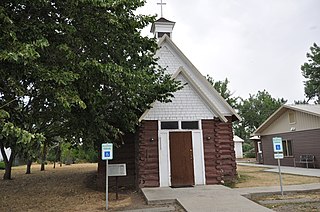
The St. Philip's Episcopal Church, at 701 Main St. in Rosebud, Montana, was built in 1906. It was listed on the National Register of Historic Places in 2007. It has also been known as the Rosebud Community Church and as the Little Log Church.
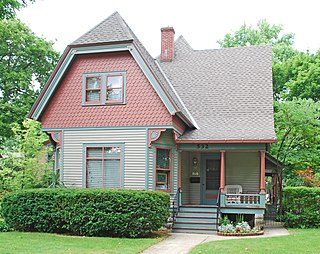
The Peter B. Appeldorn House is a single-family home located at 532 Village Street in Kalamazoo, Michigan. It was listed on the National Register of Historic Places in 1983.






















